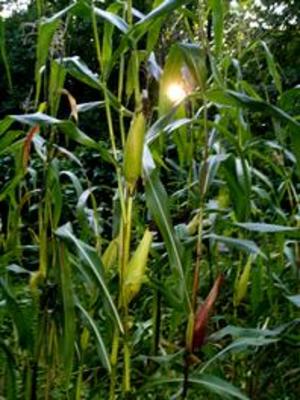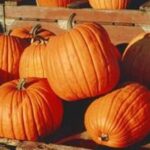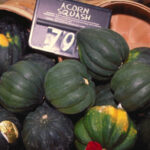Foods: Basics Include: A dozen varieties of Corn, Beans, Squash, Tomatoes, Potatoes, Maple Sugar, Pineapples, Strawberries, Sweet potatoes, Sunflowers, Wild rice, Vanilla beans, Cocoa or chocolate, Clams, Cranberries, Pumpkins, Coffee, a wide variety of Nuts, and many varieties of Peppers and many more. Today, 60% of the world’s foods are of Native American origin!
Corn stands far above most other foods as a gift of special spirit beings in many Native cultures. Its origins and uses were often dictated by ritual, ceremony, and tradition. The corn that is widely used today was still unknown until more recent times. Although corn was grown by people in Hopewellian cultures around 2,000 years ago, it was not a major product of agricultural production even during the Middle Woodland era. A type of corn that grows abundantly well in colder climates had not been fully developed until around 1000 A.D. The corncob produced, and which influenced hierarchal divisions in Mississippian cultures was no more than about 4″ in length.
Corn is used in foods such as cereals, snacks, popcorn, and for making the sweetener, High Fructose Corn Syrup which is used in soda pop, dressings, ketchup, baked goods, and hundreds of items. It is also used to manufacture plastics, soap, face cream, explosives, glue, and bio-fuels. It alone is the number three export behind wheat and rice today.
Tomatoes were introduced to Euro/Americans early, however, even in the 1830’s in the Midwest, settlers were not convinced of the flavor and safety of the fruit, still believing it was poisonous.
Animals: Native Americans domesticated turkeys, llamas, guinea pigs, and dogs
Agricultural Adaptations and Products: Terra preta soil – from a slash and char which left charcoal that was stirred into the earth for growing food (South America more than other areas)
• Canals, irrigation systems, water control of streams and ponds, control prairie fires to induce herds to come, mounds, and earthworks
• Fertilizing with organic matter including fish and by products
• Cotton, tobacco
• Rubber was used as early as 1700 B.C. The Olmec and later the Maya would collect the sap to make balls for games and many other uses. They also came up with the process of using rubber in waterproofing such items as capes, footwear, baskets, and bags
Medicines: Countless herbs and plants used for medicine– aspirin was derived from willow bark, sphagnum moss used for diapers and wound dressing. Healers possessed sophisticated knowledge of the properties and correct dosages of medicinal plants. North American Indians used botanical oral contraceptives and routinely used antispasmodic medications that were dangerous if not used in the correct dosages. The sophistication of their medical knowledge suggests that they were perceptive observers of the results of herbs used for illnesses
• Sunscreen – herbal mixtures that contain sunflower oil, or agave have been used and can still be found today
• Insect Repellent -Bear fat or wild onions, Goldenseal plant with bear fat
• Teeth Cleaning – Gold Thread rubbed on teeth; horsetails rubbed on teeth, and some used willow twigs which were made into tooth brushes
• Strawberry leaves or roots – fever, diarrhea, mouth and gum problems
• Cattail- roots for wounds, burns, diarrhea
• Ginger- earaches
• Syringes – hollow bird bone was used for the tube and needle. Instead of a plunger, they used a small animal bladder at the top. Squeezing the bladder pushed medicine through the hollow bone and into the patient. The syringe was also filled with herbal liquids and used to cleanse wounds.
Architecture: Today, southwestern architecture is influenced by some of the adobe dwellings used by Pueblo people ages ago
Camp Tents: Wigwams influenced almost all-modern domed tent manufacturing
Sauna: Sweat Lodges
Food Preservation: Smoking, Drying, Salting. Freeze Drying (Inca 1,000 AD)
Beef Jerky is the modern equivalent to smoked bison or venison produced hundreds of years ago.
Transportation: Toboggan, Canoe, Snow Shoes, Kayak, Travois for dogs and horses, baby carriers (cradleboards) Snow shoes are used in places where snow is deep and long lasting. Baby carriers and hammocks are still used today, made from modern materials.
Trails and roads: Many were bison trails, and used by first Native Americans have now become modern roads and highways. Some state highways and county roads closely follow old Indian trails and many modern towns and cities built on and around them are the sites of Native American villages. Example: The Bullskin Trail is now Ohio Route 68 and the towns of Xenia, Yellow Springs, Old Town, Springfield, Dayton, and West Liberty are all sites not far off the road and were home to specific villages of Native Americans.
Economy: Furs, Crops, Gold, Maple Sugar – In the 1500’s, Native labor produced the gold and other valuable metals helped Spain rise to its height of power. The labor of countless Native North Americans produced furs that contributed immensely to the coiffures of England, France, the Netherlands, and Russia.
Clothing and Household Furnishings: Clothing such as wrap skirts, leggings, slat wood armor, footwear, tumplines, belts, sashes, garters, capes, tunics, kilts, blankets, shawls, and coats were made thousands of years ago from native plants, feathers, and bark.
Plants such as Dogbane, Nettle, Hemp, Goosefoot, Cattails, and Maygrass were used in the production of the above named items. The plants, often harvested in the fall after the first frost, provided hair-like fibers from which twine or cordage was produced. The cordage or fibers were twined or finger-woven into textiles beginning as early as 10,000 years ago. Several sites in North America have yielded rare examples of actual pieces of ancient textiles. Other documentation for the use of textiles comes in the form of textile impressed pottery chards. These can be analyzed in the lab for structure and construction, and sometimes for its use within the culture.
Bullrushes, Cane, Cattails, Basswood, Birch, Cedar, Elm, and Tulip Poplar bark were extensively used for house coverings, making exterior and interior floor and wall coverings as well as roof covers.
Brain Tanning Leather: for Moccasins, Leather jackets, skirts, pants, leggings, shirts, robes
This process involved utilizing the physical processes of first fleshing the hide and removing the hair. Then the Native people would soak it in water, stretch it to prepare it for a bath of brains. The brains of the animal were crushed and worked into the hide until oozing through to the opposite side. Then the process involved staking the hide out and working it until it was softened. Many times it was smoked, and then cut into whatever they needed to make and embellished with quills, bone, copper, and antler beads and eventually with European glass trade beads.
Games: La Cross, Snowsnake (Early hockey) Schools today often have a form of La Cross as a major sporting activity.
Math: The Maya of Mexico first to use the zero in mathematics. Scholars believe that Asians traveled across the Pacific Ocean where they learned about the zero from the Maya.
Government: The League of the Iroquois, served as a model for the beginnings of the government in the United States. The League was made up of five separate Iroquois or Haudenosaune Nations and they had a grand council with representatives from each. Some functions of the council were left up to the grand council while many were respectively left up to the individual Nations. This system was observed by prominent American leaders and chosen as the formula for building the government of the United States.
Bibliography
Landon, Rocky, and Mac Donald, David, A Native American Thought of It, Amazing Inventions and Innovations, Annick Press, Canada
Teachers, Native American Contributions, From pineapples and pumpkins, to a model of government and the zero in math, discover some of the many contributions Native Americans have made to world cultures
Weatherford, Jack, Native Roots, How the Indians Enriched America, Crown Publishers



